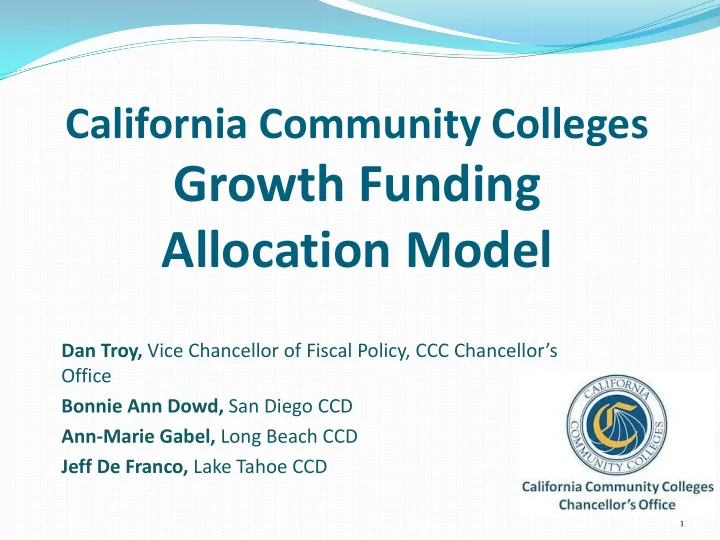

California Community Colleges Growth Funding Allocation Model Dan Troy, Vice Chancellor of Fiscal Policy, CCC Chancellor’s Office Bonnie Ann Dowd, San Diego CCD Ann-Marie Gabel, Long Beach CCD Jeff De Franco, Lake Tahoe CCD 1
Expired Growth Regulation The California Community Colleges Growth Regulation has been expired since 2008-09. Between 2008-09 and 2011-12, the community colleges suffered budget cuts forcing them to drastically reduce course offerings. Growth funding received in the last few years has been used to repay the FTES “workload reductions” that occurred because of the state budget cuts. New Growth Regulation will replace current workload restoration process as of 2015-16. 2
Legislative Interest in Addressing CCC Growth Model As the state’s fiscal outlook improved, the legislature and state administration began a renewed focus on how the system should grow as new funding is available for the community college system. Interest in reshaping the system using a funding allocation model different from prior growth models with a focus on “unmet need” throughout the state. Primary focus is on how funding is allocated among the districts (i.e., resizing) rather than how districts and the system could grow over time based upon demand. 3
State Chancellor’s Advisory Workgroup on Fiscal Affairs • Convened to provide ongoing advice and counsel to CCC State Chancellor on community college finance and business operations impacting California community colleges. • Workgroup members representative of the diversity of the 72 CCC Districts to include: districts from different regions of the state, single and multi-college districts, small and large, basic and non-basic aid districts. • Advisory Workgroup, at the request of Chancellor Harris, was charged with working on a “new growth” funding model to replace the expired growth funding formula. 4
Advisory Workgroup Membership Fifteen Members (13 Districts, CCLC and CCCO Representatives): Los Angeles CCD, Vinh Nguyen San Diego CCD, Bonnie Ann Dowd- Chair Sierra Joint CCD, Chris Yatooma Long Beach CCD, Ann-Marie Gabel- Vice Chair Grossmont/ Cuyamaca CCD, Sue Rearic Santa Clarita CCD, Sharlene Coleal Kern CCD Tom Burke Los Rios CCD, Theresa Matista Yosemite CCD, Teresa Scott , San Mateo CCD, Kathy Blackwood Community Colleges League of California Lake Tahoe CCD, Jeff De Franco (CCLC) Representative - TBD Sonoma County CCD, Doug Roberts California Chancellor Community Colleges Rancho Santiago CCD, Peter Hardash Office (CCCO) Representative, Dan Tro y, and ACBO President, (non-voting member), Fred Williams 5
SB 860 Education Trailer Bill – EC 84750.5 SB860 directed the Chancellor’s Office to develop a revised growth formula and specified primary factors that must be included in the formula: The number of people within a district’s boundaries that do not have a college degree. The number of people who are unemployed, have limited English skills, who are in poverty, or who exhibit other signs of being disadvantaged, as determined by the Chancellor, within a community college district’s boundaries. 6
Growth Allocation Model Factors The Workgroup included the factors required in the 2014-15 Trailer Bill language and added two additional factors: Educational Attainment- Percentage of individuals 25 and older in the district who do not have a bachelor’s degree Unemployment- Unemployment rate in the district Poverty(Pell Grant)- Percentage of students attending the district receiving Pell grants Participation Rate- Community college participation rate of individuals living within the district boundary Unfunded FTES- Districts 3-year average unfunded FTES, must have at least 1% per year 7
Allocation Model Methodology 1. For the first four factors, the district rate is compared to the statewide rate to determine whether the district is lower or higher than the state average. The difference between the district rate and the statewide rate is 2. constrained using a “floor” of 1 and a “ceiling” of 10. The differences are weighted and summed together to calculate 3. an index value for each district. Districts with a higher index value have a higher level of need and 4. those with a lower value have a lower level of need. Factors are based upon district boundaries and not on service 5. areas. 8
Example – Index Factors Educational Unemployment Pell Participation Unfunded Attainment Rate FTES District 62.70 10.20 40.60 3.90 0.00 Statewide 62.00 9.30 20.70 5.20 0.00 Difference 0.70 0.90 19.90 1.30 0.00 Calculation Amount 1.00 1.00 10.00 1.30 1.00 (Constrained) Note: Source of data for Educational Attainment, Unemployment, and Participation Rate is ESRI. Source of data for Pell is District MIS data. Source of data for Unfunded FTES is District Exhibit E. 9
Example – Weighted Factors Educational Unemployment Pell Participation Unfunded Attainment Rate FTES District 1.00 1.00 10.00 1.30 1.00 Constrained Index Factors Weight .2 .2 .2 .2 .2 Weighted Index 0.20 0.20 2.00 0.26 0.20 Factor + + + + = District Growth 2.86 Index Value 10
Translating the Index Value into a Funding Allocation 1. Divide each district’s Growth Index Value by 100 to get the district’s Growth Rate. Multiply each district’s Growth Rate by that district’s FTES 2. Revenue. This is the district’s unconstrained growth allocation based upon the calculated need. Using the unconstrained growth allocation calculated in step 2, 3. constrain it to the total amount of growth revenue available by multiplying the district’s unconstrained growth allocation with the statewide growth revenue and dividing by the total amount of unconstrained growth revenue calculated in step 2 above. The following example assumes that 2.03% growth is provided 4. which translates to $100 million. 11
Example – Growth Amount Growth 13-14 FTES Unconstrained Constrained Constrained Rate Revenue Growth to State Growth (as of P2) Revenue Growth Rate (System Need) Revenue (Assume $100,000,000 Available) (Unconstrained (Constrained Growth times (Growth Rate times Growth Statewide Growth 13-14 FTES Amount Revenue divided Revenue) divided by 13-14 by Unconstrained FTES Revenue) System Need) District 2.86% 88,782,246 2,539,172 2,257,346 2.54% (example) Statewide 2.76% 4,929,689,465 112,484,868 100,000,000 2.03% 12
Next Steps Roll Growth Funding Model out at Consultation Council in November 2014. Link information related to Growth Funding Model methodology on the CCCCO website. New Growth Funding Model methodology to be applied in FY2015-16 State Budget. 13
Questions? 14
Recommend
More recommend